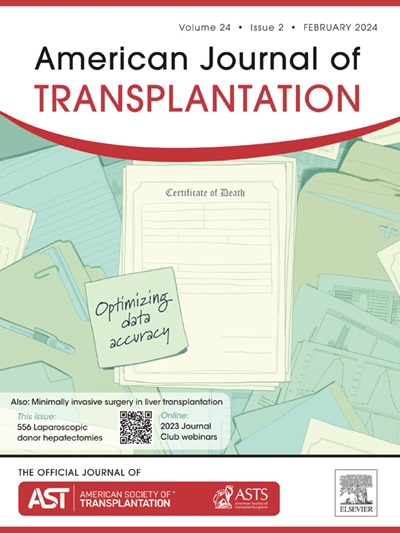STAR 2025先天工作组:先天同种异体识别在肾移植损伤中的潜在作用。
IF 8.2
2区 医学
Q1 SURGERY
引用次数: 0
摘要
在实体器官移植中,同种免疫反应传统上归因于识别不匹配的人类白细胞抗原(HLA)的同种反应性T细胞的作用,以及抗体的形成和抗体介导的排斥反应。然而,最近的证据表明,这些涉及器官移植排斥反应的适应性免疫系统的范式并不能解释所有移植炎症病例,并且先天细胞异体识别起作用。本综述由移植风险评估(STAR)工作组的致敏性先天小组进行,总结了支持先天异体识别的概念和经验证据。重点是通过SIRPα- cd47途径和SIRPα基因多态性,通过缺失自我和单核细胞激活NK细胞。提出了基因缺失自我的共识定义,需要供体和受体HLA I类基因分型,并评估受体抑制性杀伤细胞免疫球蛋白样受体(KIR)基因型。虽然体外研究和临床前验证证实了先天异体识别概念的潜力,但需要进一步的研究来建立临床效用。本文描述了未来的研究方向,以弥合理论前景与临床移植实际应用之间的差距。本文章由计算机程序翻译,如有差异,请以英文原文为准。
Sensitization in Transplantation Assessment of Risk 2025 innate working group: The potential role of innate allorecognition in kidney allograft damage
In solid organ transplantation, the alloimmune response is traditionally attributed to the action of alloreactive T cells that recognize mismatched human leukocyte antigens, as well as antibody formation and antibody-mediated rejection. However, recent evidence indicates that these paradigms of involvement of the adaptive immune system in organ transplant rejection do not explain all cases of graft inflammation and that innate cell allorecognition plays a role. This review, conducted by the innate team of the Sensitization in Transplantation Assessment of Risk workgroup, summarizes the concepts and empirical evidence supporting innate allorecognition. The focus is on natural killer cell activation via missing self and monocyte activation through the signal regulatory protein α-CD47 pathway and SIRPα gene polymorphisms. A consensus definition of genetic missing self is proposed, necessitating both donor and recipient human leukocyte antigen class I genotyping and evaluation of the recipient inhibitory killer-cell immunoglobulin-like receptor genotype. Although in vitro studies and preclinical validations corroborate the potential of innate allorecognition concepts, further research is required to establish clinical utility. This article delineated future research directions to bridge the gap between theoretical promise and practical application in clinical transplantation.
求助全文
通过发布文献求助,成功后即可免费获取论文全文。
去求助
来源期刊
CiteScore
18.70
自引率
4.50%
发文量
346
审稿时长
26 days
期刊介绍:
The American Journal of Transplantation is a leading journal in the field of transplantation. It serves as a forum for debate and reassessment, an agent of change, and a major platform for promoting understanding, improving results, and advancing science. Published monthly, it provides an essential resource for researchers and clinicians worldwide.
The journal publishes original articles, case reports, invited reviews, letters to the editor, critical reviews, news features, consensus documents, and guidelines over 12 issues a year. It covers all major subject areas in transplantation, including thoracic (heart, lung), abdominal (kidney, liver, pancreas, islets), tissue and stem cell transplantation, organ and tissue donation and preservation, tissue injury, repair, inflammation, and aging, histocompatibility, drugs and pharmacology, graft survival, and prevention of graft dysfunction and failure. It also explores ethical and social issues in the field.

 求助内容:
求助内容: 应助结果提醒方式:
应助结果提醒方式:


